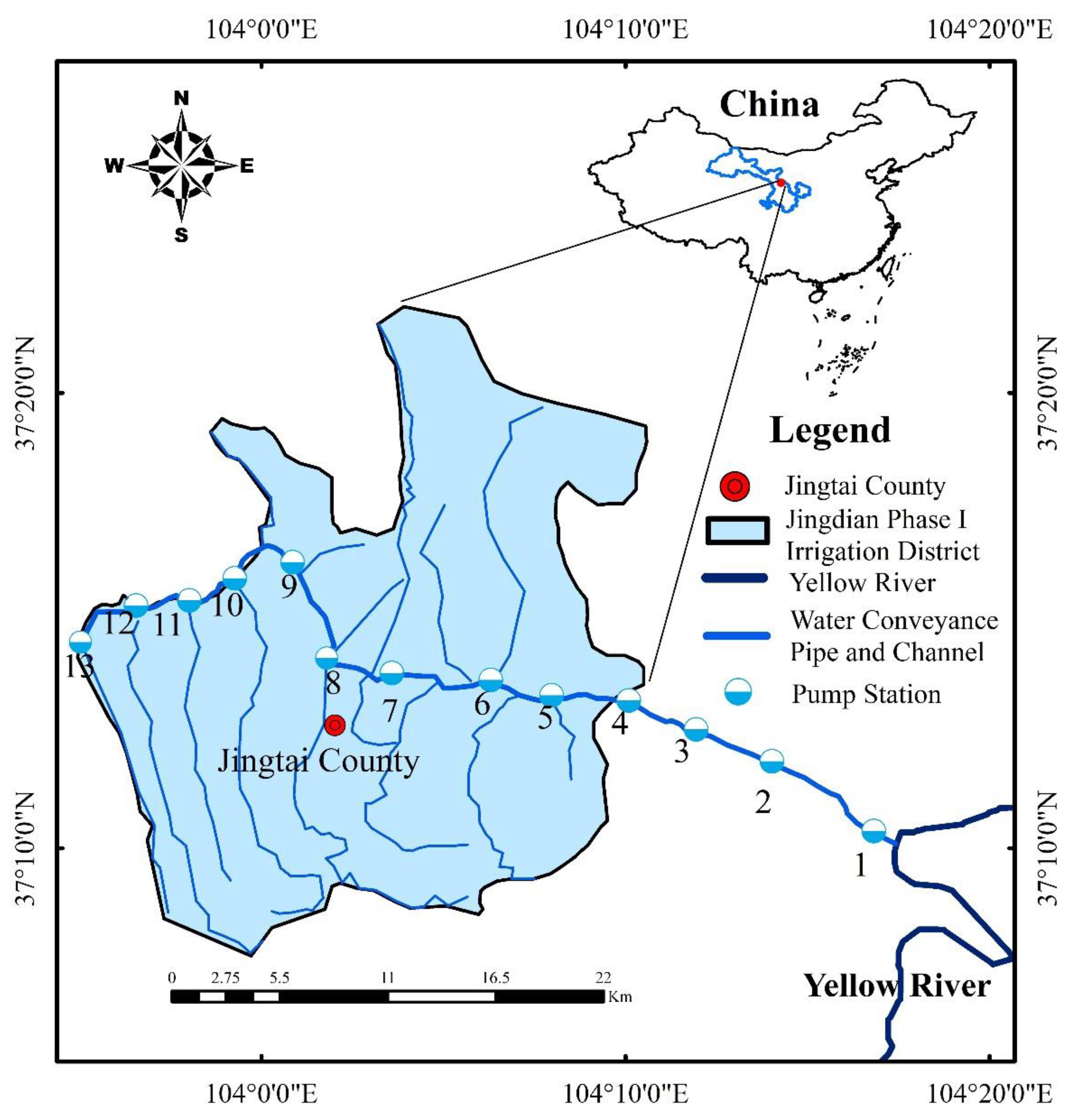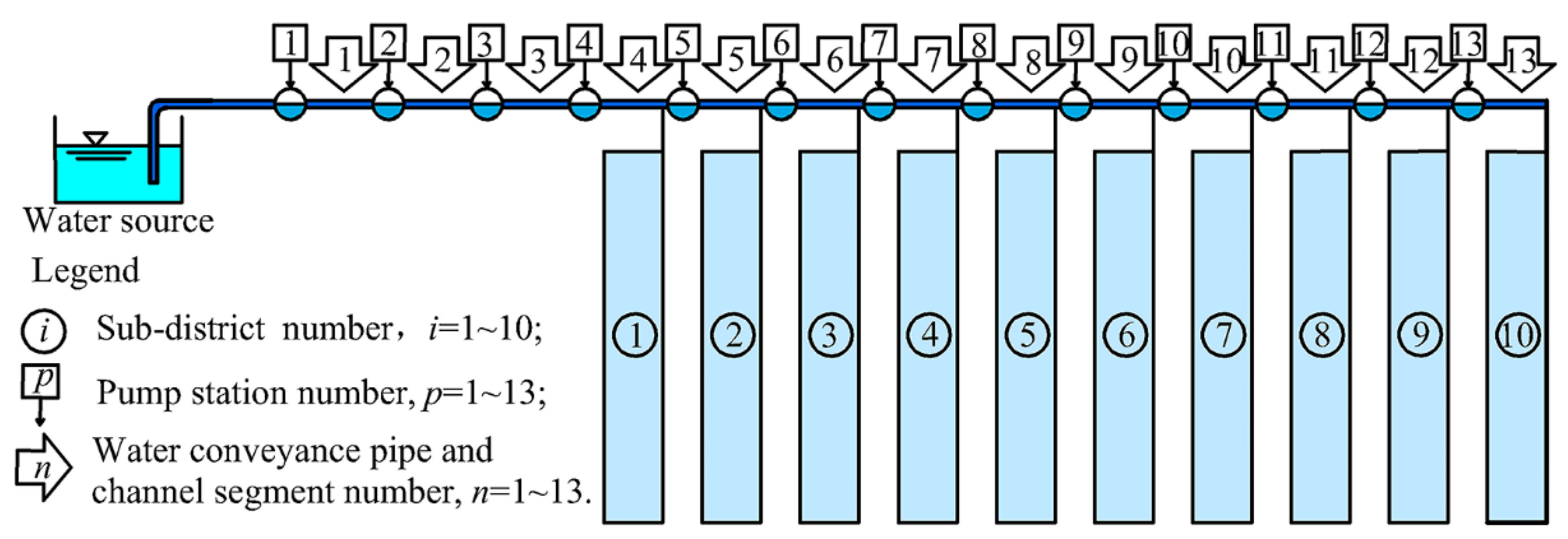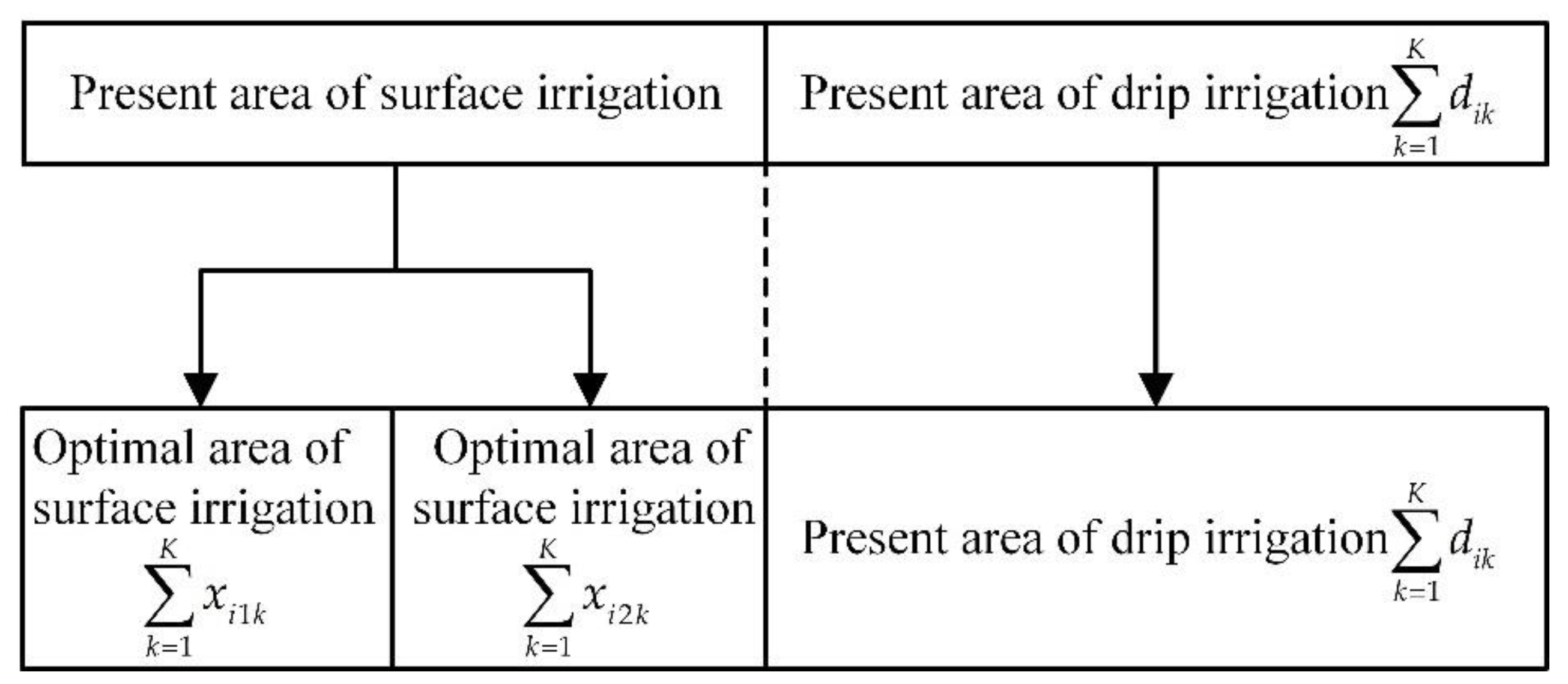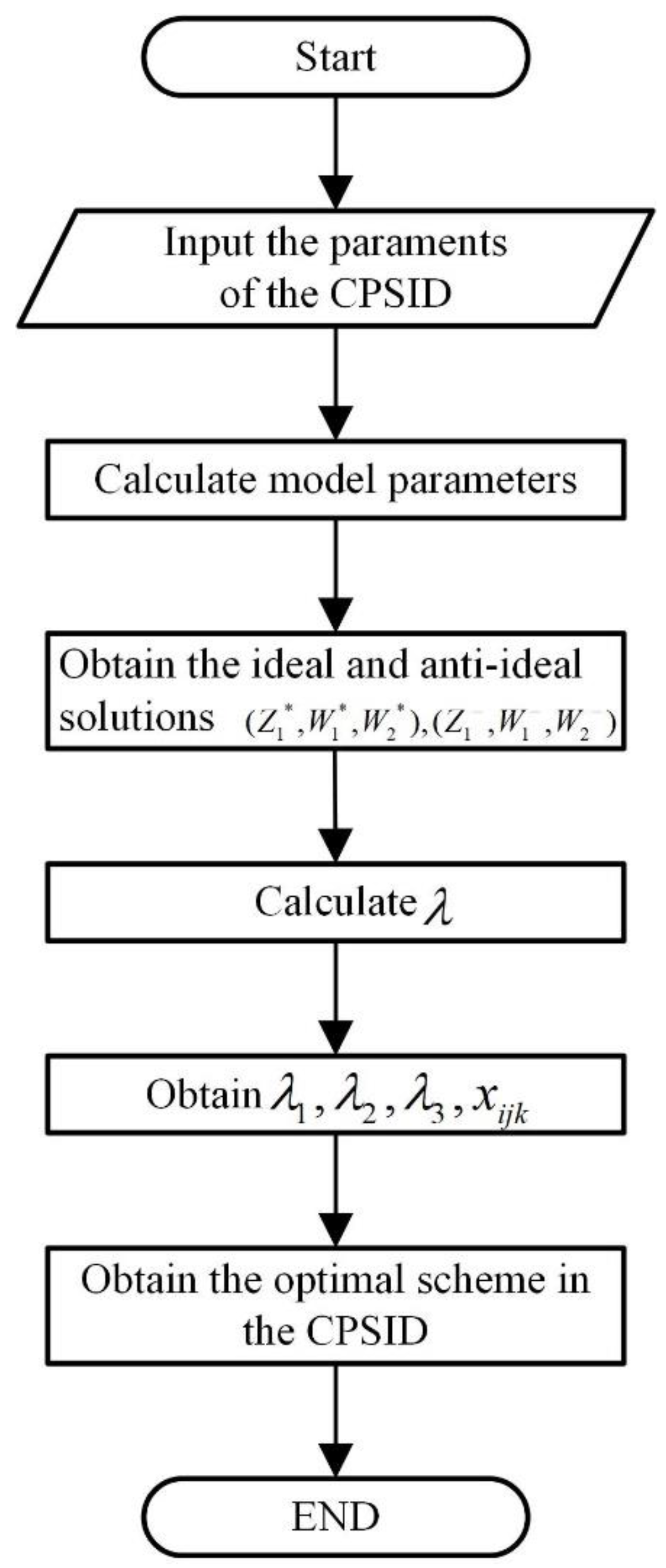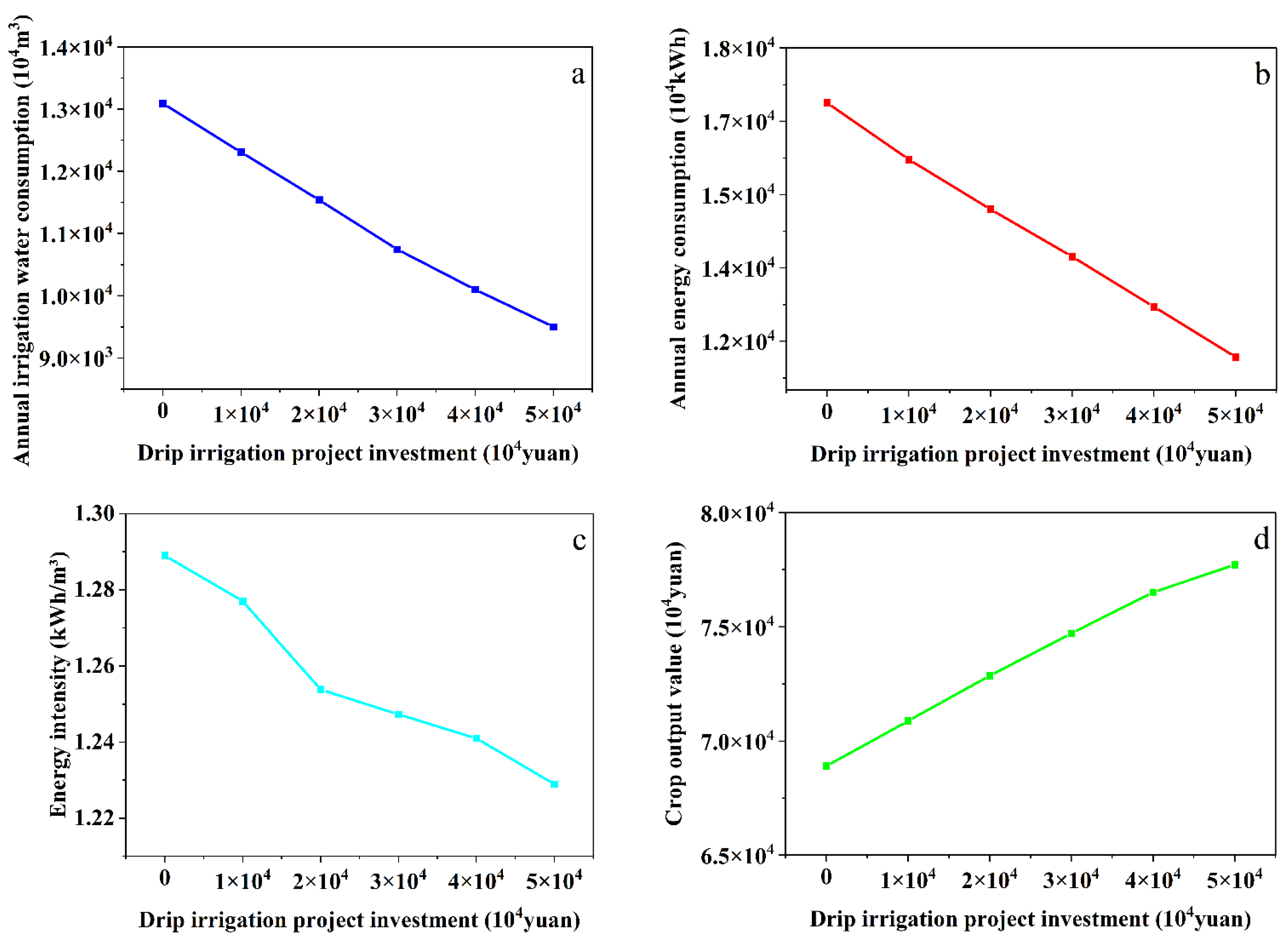1. Introduction
Cascade pump stations irrigation district (CPSID) is divided into several sub-districts according to the topography elevation difference and the distribution of pump stations. The CPSID is a complex system consisting of cascade pump stations (CPSs), channels, pipes, and sub-districts, in which each part has a close water-energy nexus. The spatial patterns of water and energy are determined by the spatial patterns of irrigation technologies and crops in each sub-district. Thus, the research objective of this paper is to obtain the optimal spatial pattern of crops and irrigation technologies, in which energy and irrigation water use are minimal, but the crop value is the highest in the CPSID.
Due to population growth and economic development, there is an expected increased demand of 50% more food, 40% more energy, and 30% more water by 2030 [
1]. Agriculture is the key link to ensure crop growth, but it consumes large quantities of water and energy. Therefore, much research has been carried out on the water-food-energy nexus in agricultural irrigation to achieve higher crop yields with less water and energy consumption [
2,
3,
4,
5,
6,
7]. Meanwhile, developing agricultural water and energy saving methods is conducive to protecting the ecological environment [
1,
8], because the saved water can be used to improve the environment [
9,
10]. Agricultural water and energy saving in irrigation pump stations can reduce greenhouse gas emissions [
11,
12].
At present, many studies have been carried out on the optimal design and scheduling of irrigation systems. The purpose of optimal design of systems is to reduce operation costs and project investment [
13,
14]. Irrigation pump station optimization scheduling can save a lot of energy [
5,
15,
16,
17]. The energy-saving effect of the optimal operation of the CPS in a long-distance water conveyance system is more significant [
18,
19,
20]. The optimization of the multi-objective scheduling model in the CPSID provides the optimal scheduling scheme with the lowest energy consumption under the constrain of irrigation water [
6].
In arid regions at high altitudes, water from rivers is diverted to the irrigation district (ID) through the CPS, into the pipes and channels of the water conveyance, and is distributed within an ID. In this type of the ID [
6,
21], the cumulative head of the CPS can reach hundreds of meters, necessitating heavy consumption of energy and water to irrigate crops. Therefore, researchers face the challenge of optimizing the CPSID model in a manner that saves water and energy, increases the output value of crops, and achieves optimal allocation within the water-food-energy nexus. This challenge may be achieved through two methods: the use of drip irrigation in place of surface irrigation and the adjustment of crop planting structures [
22,
23,
24]. Drip irrigation offers the advantages of conserving water, increasing crop income, and protecting the environment [
25,
26]. Adjustments of crop planting structure can exchange crops with high water consumption and low output value with crops with low water consumption and high output value [
27,
28,
29,
30,
31]. The water-saving irrigation in the ID with pump stations will also bring remarkable energy-saving effects [
24]. Based on the topographic characteristics and the present engineering facilities of the CPSID, the problem is how to combine the two aforementioned methods to obtain the optimization scheme of the spatial patterns of crops and irrigation technologies in the CPSID, to reduce energy and water consumption, and to improve crop output value. More research is required on this issue.
We need to consider three optimization objective functions: the minimum annual irrigation water consumption, minimum annual energy consumption, and maximum crop output value in the ID. An example of an optimization mathematical model is multi-objective linear programming (MOLP). Fuzzy set theory is an ideal approach for obtaining the compromised solution of multi-objective linear programming [
32]. In order to obtain the non-inferior solution of multi-objective linear programming, a two-stage algorithm based on fuzzy sets is proposed [
33,
34]. The solution obtained by using the two-stage algorithm of multi-objective linear programming is better than that obtained by using the maximum (minimum) algorithm, which indicates that the solution obtained by the two-stage algorithm of multi-objective linear programming is valid. Interval linear programming (ILP) is one method for modeling problems under uncertainty [
35]. The ILP models can assess problems under uncertainty much better, due to the use of the qualitative concepts in the form of an interval. The MOLP for solving models includes interactive approaches, optimization methods, goal programming, and fuzzy method [
35,
36,
37]. Thereafter, some modified maximum regret approaches were presented to find a necessary efficient solution to an interval MOLP problem [
38,
39,
40]. In a multiple objective linear programming problem, parameters such as coefficients and right-hand side values of the constraints are uncertain. To cope with such uncertainties, a multi-choice goal programming model with a limited number of choices for a parameter is presented [
41,
42]. The general mathematical programming model for a multi-choice multi-objective linear programming problem as an extension of recent work is established [
35,
43]. Inverse optimization (IO) is a field of optimization dealing with problems in which some of the parameters may not be precisely known, and only estimates of these parameters may be known [
44]. Mostafa Naghavi [
45] put forwards the inverse optimization method of multi-objective linear programming for the least problem modifications to make a given feasible solution for a weakly efficient solution. A KKM approach is the new algorithm for IO based on capacitated transportation problems in a neutrosophic environment [
46]. In application problems, the decision-maker may often encounter a problem to optimize the ratio with both the denominator and numerator being linear. If the ratio is considered as an objective function, then under linear constraints the problem is said to be linear fractional programming (LFP). In recent years, some algorithms have been proposed to solve LFP problems [
47,
48,
49].
This paper is organized as follows. In
Section 2, The information of the study area is introduced. The multi-objective linear programming and calculation of water and energy spatial patterns in the CPSID are introduced in
Section 3. In
Section 4, we obtain the optimal scheme of water and energy spatial patterns of the Jingdian Phase I Irrigation District. Then, we analyze changes in various indexes of the optimal scheme under different drip irrigation project investment, and we further discuss the sustainable development of the CPSID.
Section 5 presents the conclusion.
2. Study Area
Data for the Jingdian Phase I Irrigation District were obtained from the administrative department of the district, namely the Jingtaichuan Electric Lifting Irrigation Water Resources Utilization Center of Gansu Province.
The Jingdian Phase I Irrigation District is located in the central region of Gansu Province, in northwest China (103°20′–104°04′ E and 37°26′–38°41′ N).
Figure 1 shows the location of the ID, with an elevation of 1561 to 1757 m. The average annual rainfall is 184 mm, and the average annual evaporation is 2290 mm. Therefore, the Jingdian Phase I Irrigation District is located in an extremely arid area, and irrigation is the primary crop water source.
The terrain elevation difference is very large in the Jingdian Phase I Irrigation District. According to the elevation difference and the distribution of CPS, the ID is divided into 10 sub-districts (
Table 1). Water from the Yellow River is transported to the farmland through the CPS, water conveyance pipe and channel (WCP&C), as well as the water distribution pipe and channel system (WDP&CS) of each sub-district. The main crop irrigation techniques for the farmland in the ID are surface and drip irrigation. The Jingdian Phase I Irrigation District comprises a complex system (
Figure 2) of a water source (the Yellow River), 13 CPSs, 13 WCP&C segments, and 10 sub-districts. The WCP&C is composed of pressure pipes and open channels. Each sub-district contains farmland and WDP&CS; the WDP&CS consists of open channel systems and pipe networks. The water from the WCP&C is diverted to the farmland by the open channel system for surface irrigation. The water from the WCP&C is sent to the drip irrigation emitter near the crops through pipe networks.
The parameters of the pump stations are shown in
Table 2.
Table 1 shows the irrigation water use efficiency of different irrigation technologies in each sub-district. The water use efficiency of the WCP&C segment is shown in
Table 3. The parameters of the irrigation technologies are shown in
Table 4.
The spatial patterns of crops and irrigation technologies for the Jingdian Phase I Irrigation District in 2020 are listed in
Table 5. The annual irrigation water consumption was 14,219 × 10
4 m
3, the annual energy consumption was 18,770 × 10
4 kWh. The crop output value was 65,244 × 10
4 yuan, and the irrigated area was 21,952 ha. The drip irrigation area comprised 7.56% of the total irrigated area.
4. Results and Discussion
The drip irrigation investment in the Jingdian Phase Irrigation District was 40,000 × 10
4 yuan, and the value and data presented in
Table 1,
Table 2,
Table 3,
Table 4,
Table 5 and
Table 6 were input to the objective functions (4)–(6) and the constraint conditions (7)–(12). The ideal solutions (
,
,
) and the anti-ideal solutions (
,
,
) were (765,307,095, 97,249,784, 122,606,014) and (510,911,364, 146,310,129, 192,864,931), respectively.
In the first step, the problems (18)–(22) are a linear programming problem, calculated with MATLAB toolbox, Z1 = 761,502,174 yuan, W1 = 102,258,392 m3, and W2 = 129,099,716 kWh, λ = 0.49.
In the second step, the problems (23)–(26) are also a linear programming problem, calculated with MATLAB toolbox, Z1 = 766,902,174 yuan, W1 = 100,353,658 m3, W2 = 126,016,650 kWh, and λ1 = 0.52, λ2 = 0.81, λ3 = 0.62.
The calculation result of the second step is better than that of the first step. The calculation results of the example in literature [
34,
35] are similar to those in our paper, so we choose the calculation results of the second step.
According to the
xijk obtained in the second step and the present area of various crops in drip irrigation (
Table 5). The optimal scheme of the spatial patterns of crops and irrigation technologies in the Jingdian Phase I Irrigation District were obtained (
Table 7).
The data for the optimal scheme (
Table 7) can be substituted into Equations (1)–(3) for calculation of the annual irrigation water consumption, annual energy consumption, and crop output value of the ID (
Table 8). Compared with the 2020 conditions (
Table 5), the optimal scheme could reduce the annual irrigation water and energy consumption by 3722 × 10
4 m
3 and 5515 × 10
4 kWh, respectively. Furthermore, it could increase the crop output value by 19,277 × 10
4 yuan; that is, the scheme could reduce water and energy consumption by 26.18% and 29.38%, and increase income by 29.55%.
A comparison of the spatial patterns in 2020 (
Table 5) and that of the optimal scheme (
Table 7) reveals that: (1) The spatial distribution of crops in each sub-district of the present situation is less concentrated than that of the optimal scheme. For example, there are currently eight crops in surface irrigation in sub-district 7, but only one crop in surface irrigation in the optimal sub-district 7 (
Table 7). The centralized distribution of crops in the optimal scheme is beneficial to modern agriculture’s large-scale and intensive management. (2) In the optimal scheme, the area of drip irrigation increased from 1660 ha to 9810 ha (
Table 8), which is 44.7% of the ID’s total area. After the optimization, the areas of drip irrigation in the low elevation sub-districts 1–4 remained almost unchanged, while those in the high elevation sub-districts 5–10 increased obviously (
Table 8). The increase of the drip irrigation area in the high elevation sub-districts was much bigger than in the low elevation sub-districts. The reason is that the higher the elevation of the sub-district, the longer the distance of water transportation, which leads to a greater water loss. For the same crop, the net irrigation quota of drip irrigation is lower than that of surface irrigation (
Table 4); therefore, the area of drip irrigation is greatly increased in the high elevation sub-districts, resulting in significant water saving and energy saving effects. (3) In the optimal scheme, the planting structure changed considerably (
Table 7). The areas of grain crops with high water consumption and low output values decreased significantly. For example, the areas of wheat and corn reached the lower limits of the constraint conditions (
Table 6 and
Table 7). By contrast, the areas of crops with low water consumption and high output values increased significantly. For example, the areas of fruit trees, vegetables, and potatoes all reached their upper limits (
Table 6 and
Table 7). In the optimal scheme, the spatial patterns of crops and irrigation technologies were adjusted synchronically. For instance, fruit trees provide a high output value with a low net irrigation quota per unit area and low investment in drip irrigation per unit area (
Table 3). Therefore, drip irrigation was applied to all fruit trees while the area reached the upper limits of constraint conditions (
Table 6). The above adjustment is beneficial to water saving, energy saving, and output increasing.
A comparison of the indicators (
Table 8) from the present situation (
Table 5) and those of the optimal scheme (
Table 7) reveals that: (1) For sub-districts 1 and 2, the two indexes of each sub-district (irrigation water consumption and annual energy consumption) increased after the optimization. However, for sub-districts 3–10, these two indexes were smaller than the present situation (
Table 8). If the whole ID is taken into consideration, the two indexes were lower than the present situation. The optimal scheme can save 26.18% water and 29.38% energy compared with the present situation. (2) For sub-districts 2–4, the output value of crops in each sub-district for the optimal scheme was lower than the present situation, while for sub-districts 5–10, the output value of crops increased after the optimization (
Table 8). From the perspective of the whole ID, the output value of crops in the optimal scheme was higher than the present situation (
Table 8), indicating that the optimal scheme adjusts crops with a high output value to the high elevation sub-districts. (3) Although the three indexes of the optimal scheme (annual irrigation water consumption, annual energy consumption, and crop output value) were not as good as the present situation in some sub-districts, they were better than the present situation in the rest of the sub-districts (
Table 8). From the perspective of the whole ID, the three indexes of the optimal scheme were better than the present situation (
Table 8), indicating that the optimization reached a global solution instead of a local one, which also shows the rationality and correctness of the optimization model and solution method. To increase the drip irrigation area, it is necessary to increase drip irrigation project investment. Different optimal schemes can be obtained when the drip irrigation project investment is 10,000 × 10
4 yuan, 20,000 × 10
4 yuan, 30,000 × 10
4 yuan, 40,000 × 10
4 yuan, and 50,000 × 10
4 yuan, respectively. The annual irrigation water consumption, annual energy consumption, and crop output value of different investment optimization schemes can be obtained by using Equations (1)–(3). The annual irrigation water and energy consumption in the ID demonstrated a decreasing trend with an increase in drip irrigation investment (
Figure 5a,b). Energy intensity is an important indicator to measure energy conservation in the CPSID [
7]. The energy intensity in the ID demonstrated a downward trend with an increase in drip irrigation investment (
Figure 5c), indicating that the CPSID can achieve significant energy conservation by saving water. The crop output value demonstrated a rising trend (
Figure 5d).
The whole Jingdian Irrigation District consists of two-phase projects: Jingdian Phase I Irrigation District and Jingdian Phase II Irrigation District. The two projects are independent irrigation systems adjacent to each other. Non-point source pollution and soil salinization are environmental problems closely related to irrigation [
50], especially in semi-arid areas where water resources are scarce due to excessive irrigation. The Jingdian Phase I Irrigation District drainage is into the Yellow River. The Jingdian Phase II Irrigation District drainage is into the desert. The irrigation water consumption of the Jingdian Phase I Irrigation District is relatively large, mainly due to the large proportion of high water-consuming crops planted by surface irrigation. In addition, the ID uses many chemical fertilizers; part of the chemical fertilizers enters the Yellow River with the drainage of the ID and pollutes the water source. By optimizing the crop planting structure in Jingdian Irrigation District [
27,
28], irrigation water consumption can be reduced, and farmland drainage can be reduced by 5.21~8.93%, effectively reducing agricultural non-point source pollution and soil salinization. In the Violada Irrigation District, the nitrate load decreased by 70.4% after replacing the surface irrigation with sprinkler irrigation [
51]. If the model proposed here is adopted to optimize crop planting structures and the spatial patterns of irrigation technologies are considered simultaneously, the agricultural irrigation water consumption and farmland drainage in the Jingdian Irrigation District will be reduced, and the pollution degree of farmland drainage to the Yellow River will also be reduced.
Drip irrigation can reduce harmful gas emissions [
52]. The experimental results show that drip irrigation reduced nitrous oxide and nitric oxide by 13.0% and 16.7%, respectively, compared with surface irrigation [
26,
53].
Developing a water-saving irrigation method and controlling water consumption are effective measures to protect the environment in arid regions [
8,
9,
10]. Moreover, the area constraint of each sub-district in the optimization model in this paper avoids the trend of ecological deterioration caused by blindly expanding irrigation areas in arid regions [
10,
11]. The research shows that under the condition of keeping the irrigation area unchanged, the optimization scheme can save water, save energy, and increase crop income. This is conducive to the simultaneous improvement of economic, social, and ecological benefits and to guarantee the sustainable development of the CPSID.
The quantitative analysis of the ecological and environmental benefits of the optimized spatial patterns of crops and irrigation technologies in the Jingdian Phase I Irrigation District should be further explored. The contents to be further studied include soil salinization, non-point source pollution, and harmful gas emissions reduction by drip irrigation in the CPSIDs. These problems are also the limitations of this study. Further study could supplement the ecological environment benefit maximization of the target function. Drip irrigation has the effect of reducing the salt alkalinity, non-point source pollution, and harmful gas discharge. Based on this effect, the constraint is added in the model. Of course, these further studies require a lot of experiments, using measured data, obtaining the parameters required in the model, and improving the model. We will also carry out further research regarding the uncertainty of the model parameters [
35,
36,
37,
44,
45,
46].
